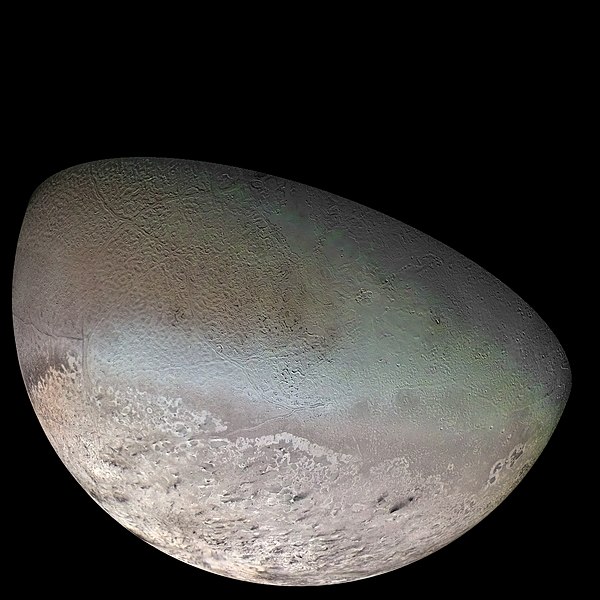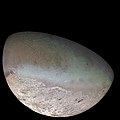Fichier:Triton moon mosaic Voyager 2 (large).jpg
Apparence

Taille de cet aperçu : 600 × 600 pixels. Autres résolutions : 240 × 240 pixels | 480 × 480 pixels | 768 × 768 pixels | 1 024 × 1 024 pixels | 2 048 × 2 048 pixels | 4 700 × 4 700 pixels.
Fichier d’origine (4 700 × 4 700 pixels, taille du fichier : 12,11 Mio, type MIME : image/jpeg)
Historique du fichier
Cliquer sur une date et heure pour voir le fichier tel qu'il était à ce moment-là.
| Date et heure | Vignette | Dimensions | Utilisateur | Commentaire | |
|---|---|---|---|---|---|
| actuel | 10 octobre 2011 à 20:40 |  | 4 700 × 4 700 (12,11 Mio) | Jbarta | Minimally compressed JPG from TIFF original at NASA. This image has already been colored by NASA. I think we have no business trying to "fix" the coloring. The only alteration made from the NASA original is to enlarge the canvas to enclose the complete sp |
| 1 janvier 2010 à 22:00 |  | 4 600 × 4 600 (2,81 Mio) | Supportstorm | Image Adjustments: Auto levels on contrast and color | |
| 18 février 2008 à 22:59 |  | 4 600 × 4 600 (1,71 Mio) | Kaldari | same image, better dimensions | |
| 8 avril 2005 à 05:59 |  | 4 500 × 3 500 (1,96 Mio) | Bricktop | same image, higher resolution | |
| 3 avril 2005 à 18:13 |  | 1 024 × 796 (150 kio) | Smartech~commonswiki | A color mosaic of Triton, Neptune's moon (large). Taken by Voyager 2 in 1989. Color was synthesized by combining high-resolution images taken through orange, violet, and ultraviolet filters; these images were displayed as red, green, and blue images and |
Utilisation du fichier
La page suivante utilise ce fichier :
Usage global du fichier
Les autres wikis suivants utilisent ce fichier :
- Utilisation sur af.wikipedia.org
- Utilisation sur an.wikipedia.org
- Utilisation sur ar.wikipedia.org
- Utilisation sur ary.wikipedia.org
- Utilisation sur arz.wikipedia.org
- Utilisation sur ast.wikipedia.org
- Utilisation sur azb.wikipedia.org
- Utilisation sur az.wikipedia.org
- Utilisation sur be-tarask.wikipedia.org
- Utilisation sur be.wikipedia.org
- Utilisation sur bg.wikipedia.org
- Utilisation sur bn.wikipedia.org
- Utilisation sur bn.wikibooks.org
- Utilisation sur bs.wikipedia.org
- Utilisation sur ca.wikipedia.org
- Neptú (planeta)
- Satèl·lit natural
- Satèl·lits de Neptú
- Voyager 2
- Cronologia del descobriment dels planetes del sistema solar i dels seus satèl·lits naturals
- Viquipèdia:Articles espacials seleccionats
- Plantilla:Article espacial 01
- Llista d'objectes del sistema solar en equilibri hidroestàtic
- Llista de satèl·lits naturals
- Nomenclatura dels satèl·lits naturals
Voir davantage sur l’utilisation globale de ce fichier.


